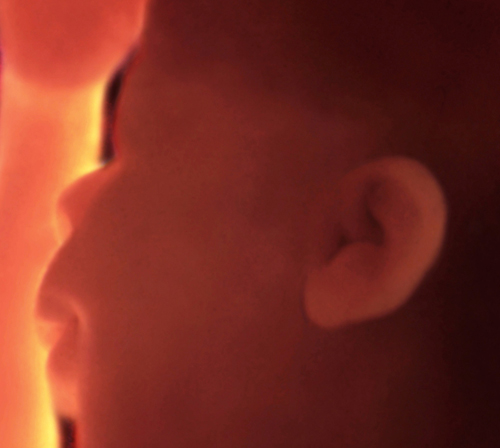You are 36 Weeks and 4 Days 24 days to go…
Your baby is losing the downy hair that he’s had for several weeks, but if he’s born now there may still be some visible.
Your baby today
Your baby is now more suitably equipped for the time after the
birth: his ears are fully formed on the outside and inside and he is
used to hearing the sound of your blood circulating and your heart
beating, and he recognizes your voice.

Lanugo is extremely fine hair
that covers your baby’s body and, unlike adult hairs on the body, it is
not associated with sweat glands. Lanugo hairs begin to be shed now
since they are lost into the amniotic fluid in the last few weeks before
birth. Your baby then swallows these lanugo hairs in the amniotic fluid
but this is not a cause for concern: these hairs provide your baby with
an important source of protein, essential to his development. It’s been
estimated that two-thirds of the protein in the fluid is swallowed and
absorbed by the baby’s gut each day, providing 15 percent of his protein
needs.
The fine lanugo
hairs are gradually replaced by vellus hairs, which are short, soft,
nonpigmented hairs (often seen more on women and children). Terminal
hair is the thicker, coarser, and longer hair that first grows on your
baby’s eyebrows, then his eyelashes, then his scalp. In adults, facial
hair (beards), armpit, and pubic hair, is terminal hair.
… Your body
Desperate for a toilet
In the third trimester you’ll be frequenting the bathroom regularly,
as you did in the first trimester. At this stage it’s due to the
increasingly heavy baby pushing down on your bladder from above. If you
find that it hurts when you expel urine, you may have a urinary
infection and should contact your doctor for a test.
… Doctor
| Q: |
I’ve heard about doctors “turning” breech babies. How does this work?
|
| A: |
Some obstetricians may try to turn a baby in late pregnancy
using external cephalic version (ECV), which has a success rate of
around 50 per cent. The obstetrician tries gently to guide the baby into
a head-down position by pressing his hands on the mother’s abdomen,
using an ultrasound as a guide. You may be given a drug to relax the
uterine muscles. You will be scanned first and if the baby is in an
awkward position the procedure may not continue. If your baby is large
this can affect the procedure, as can the amount of amniotic fluid: a
low amount of fluid offers less protection to the baby.
If you’re Rh negative,
you may get an injection of Rh immunoglobulin (RhIg) after the version
because of the small risk of a bleed around the placenta. An ECV is not
recommended if you have a multiple pregnancy, have had bleeding, your
placenta is low-lying, your membranes have ruptured, or there is a known problem with the baby.
|
The doctor will examine your abdomen in late pregnancy to check the position of the baby. If the baby is breech, an ECV may be recommended to turn him into a head-down position. If he doesn’t turn, a cesarean delivery may be necessary.

You are 36 Weeks and 5 Days 23 days to go…
Don’t be concerned about embarrassing yourself in labor—your caregivers will have seen it all before.
Your baby today
3D views at this stage of the pregnancy will be extremely clear.
Every part of the face is fully developed and your baby will be very
expressive. Your baby is only a few days away now from being full term.

Many women worry about losing control
during labor—for example that they will urinate or defecate when they
are pushing. You might well pass a bit of stool when you’re pushing but
you probably won’t notice; your doctor will put on a pair of gloves and
use gauze to remove it.
The reality is that when you’re in the throes of labor, you really won’t care—you’ll just want that baby out!
… Panel
| Q: |
What if I can’t deal with the pain of labor?
|
| A: |
Doctor:
If you’re concerned, take time to investigate the pain-relief options
in advance of labor, so that you’re aware of what’s available, even if
you don’t plan to use it.
There’s no
shame in deviating from what you requested in your birth plan; the
ultimate goal is to deliver a healthy baby, and to keep your energy
levels and your spirits high. It’s also important to ask for pain relief
as soon as you feel that things are getting away from you.
|
| A: |
Mom:
When I was in labor, the pain literally took my breath away, and I
really did feel that I would be unable to continue. Changing position,
walking around, and using a birthing ball proved to be a good
distraction, even if they passed the time rather than provided relief,
and I chanted to myself, over and over, “You can do it!” I dimly
remembered that when the pain is at its worst you’ve hit “transition,”
which signals the beginning of the delivery itself, and it did help to
know I was near the end, even if it did seem a long time in coming.
Focus on how much you want your baby in your arms, and view every
contraction as one step closer to that moment.
|
| A: |
Midwife:
Moms who are prepared for the pain seem to find that it isn’t as bad as
they thought it might be, and are able to cope using breathing
exercises and massage. The best advice is to know your limits. If you
find the pain unbearable, then ask for some pain relief. Ask the doctor
or nurse what pain options are available to take the edge off of the
discomfort, and make the process more bearable.
No woman can
anticipate how her labor and delivery will proceed, and sometimes babies
make things difficult by presenting themselves in awkward positions, or
simply enjoying life inside a little too much to arrive promptly. Take
things one step at a time, and when you know you’ve had enough, conserve
your energy by getting the help you need. Any woman who delivers a
healthy baby has had a successful delivery, and that’s what’s most
important.
|
Keep an open mind about pain relief since you won’t know how you’ll handle the pain or what your pain threshold is until you’re actually in labor.
